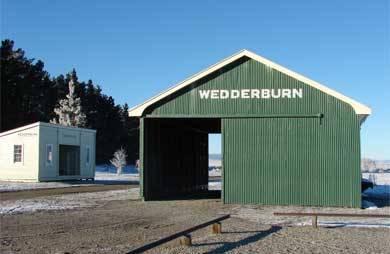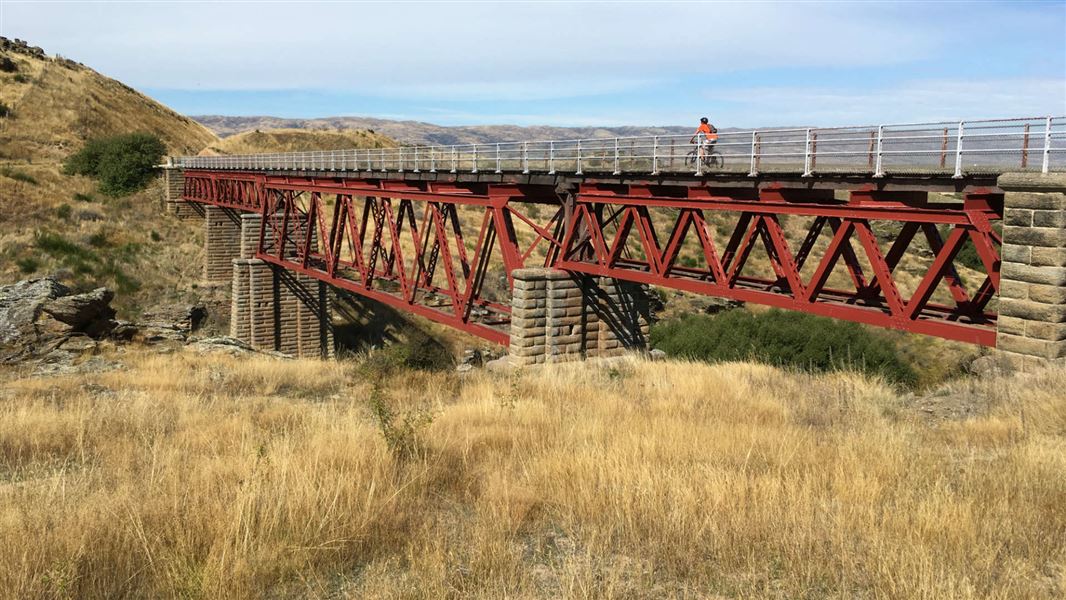This popular cycle journey through beautiful pastoral landscapes offers a taste of genuine small community hospitality. Gold and pastoral farming was the heart of Central Otago's economy and the railway provided the life blood for these isolated communities.
150 km one way
Image gallery
This is a Tohu Whenua heritage site. Located in stunning landscapes and rich with stories, these sites offer some of our best heritage experiences.
About the trail
The 3-4 day Otago Central Rail Trail is a unique recreational experience, following the former Otago Central Branch Railway for 150 km from Middlemarch to Clyde. The rail trail is very popular and used annually by thousands of cyclists and walkers from around the world.
It was developed by DOC in partnership with the Otago Central Rail Trail Trust for walkers, cyclists and horse riders.
Since the closure of the railway in 1990, more than 60 bridges have been redecked and have had hand rails added to make them safe for trail users. The crushed rock ballast of the railway foundation has also been removed and replaced with gravel to improve the surface.
The Otago Rail Trail joined Nga Haerenga, New Zealand Cycle Trail in March 2012.
Things to see
- Superb examples of the stonemason's art on even the smallest bridges and culverts.
- Prices Creek tunnel and viaduct between Hyde and Tiroiti.
- Winding through the beautiful Taieri Gorge with great views of the river and, in autumn, the colours of the leaves as they turn.
- The art deco buildings and restored railway station at Ranfurly.
- The Golden Progress mine, poppet head and other gold mining relics, a short bike ride off the trail near Oturehua.
- The schist bluffs, tunnels and viaduct of the Poolburn Gorge.
- The remnants of the historic workers' camp in the Poolburn Gorge.
- Country pubs in trailside towns: Waipiata, Lauder, Wedderburn and Chatto Creek.
- The wild thyme and schist landscape around Alexandra.
- Extensive views of Central Otago's 'Big Sky' landscape. Tor-studded ranges and hills and expansive upland basins, made famous through the paintings of Grahame Sydney the poetry of Brian Turner and the photography of Gilbert van Reenan.
Where to stay
On the trail there are two basic camping areas with toilets. One is between Daisybank and Tiroiti, the second is between Waipiata and Kokonga.
Non-DOC camping grounds are located in Middlemarch, Ranfurly, Omakau, Alexandra, and Clyde.
Other accommodation (hotels, backpackers) is available in Middlemarch, Waipiata, Ranfurly, Wedderburn, Lauder, Omakau, Ophir, Alexandra, and Clyde.
The Otago Central Rail Trail website has a list of accommodation options.
Farming and gold
The first European settlers in Central Otago came to the district in the 1850s as sheep farmers. People flocked to the area after the discovery of gold in 1861 at Gabriells Gully. The region prospered and in 1891 work began on a railway that would link Dunedin, then the country’s largest city, to the goldfields.
The ‘mile a year’ railway
It took dozens of labourers, stonemasons, blacksmiths and engineers 16 long years to build the 150 km of railway from Middlemarch to Clyde. The railway linked economic and cultural life throughout Central Otago, bringing essential supplies to one of the countries most isolated regions.
Original economic benefit
The railway had a huge impact on the local economy and towns such as Ranfurly sprung up along the line. While Ranfurly thrived, Naseby, which had been the major Maniototo township, declined. This was the fate of several towns further away from the railway route.
A return to farming
Eventually gold production declined and farming was once again the region's main industry.
New Zealand’s first rail trail
In 1990 the 150 km stretch of railway from Middlemarch to Clyde closed and the line was pulled up. In 2000 this section of the line was officially reopened as New Zealand’s first rail trail.
Since opening, the rail trail has attracted thousands of visitors to the area each year, providing job opportunities and revitalising the regions economy.
Historical highlights
Viaducts, stonework, bridges and some of the old railway stations have been maintained, preserving the heritage of the old railway line and making this New Zealand’s most popular rail heritage experience.
Highlights along the rail trail include: Tunnellers Camp, the art deco town of Ranfurly, the Poolburn Gorge, and the iconic Wedderburn Station made famous by Graham Sydney.
DOC's work
DOC has a strong partnership with the Otago Central Rail Trail Trust. The Trust has been instrumental in the success of the rail trail, raising funds for upgrades, and contributing voluntary labour.
Upgrade work has included re-decking bridges, and installing signage, interpretation panels, toilets and shelter sheds along the track. A particular challenge has been experimenting with methods to improve the rough surface of the old railway to give cyclists a smooth ride.

Wedderburn Station buildings
Image: DOC
Together the Trust and DOC have worked with local communities to bring back and preserve railway heritage, such as the iconic Wedderburn Station goods shed.
The community rallied together to get the shed, which was made famous in the Grahame Sydney painting 'July on the Maniototo', returned to its original site. The accompanying station building was also returned to the site and restored.
The rail trail has revitalised the region’s economy by bringing a huge number of people to the area and providing employment opportunities in local communities.
Maintaining the trail requires major annual work including weed control, clearing of hundreds of culverts, and bridge maintenance.
The Trust and local communities work closely with DOC to contribute to the upkeep and enhancement of the trail.Opportunities exist for companies or organisations wanting to be involved in conservation to help DOC undertake this work.
Further reading
Dangerfield, JA & Emerson, GW. (1995) Over the garden wall: the story of the Otago Central Railway (Otago Railway & Locomotive Society
The following publications were commissioned by DOC.
Hamel, J. (1996) Archaeological assessment of the Otago Central rail trail: the line today. Conservation Advisory Science Notes no.137 (Department of Conservation, Wellington).
Hamel, J. (2001) The archaeology of Otago (Department of Conservation, Wellington).
Hamel, J. (1994) Otago central rail trail: an archaeological assessment. Conservation Advisory Science Notes no.97 (Department of Conservation, Wellington).
Related links
- Taieri Gorge Railway Catch a steam train from Dunedin to Middlemarch
- Otago Central Rail Trail website
What to expect
The track
The rail trail is similar to riding or walking on a reasonably level gravel road or track, as the gradient rarely exceeds 1 in 50. The trail surface is gravel, so you can expect some bumps and loose material. The track is wide enough to allow for side-by-side riding.
Walkers, cyclists, dogs and horses all share the track, so take care and respect other users.
Weather
The trail gets very hot in summer and temperatures can reach 30 degrees Celsius. Sections of the track are exposed with little shelter, so pack sun protection and plenty of water.
In winter, temperatures can be cold with frosty mornings.
Strong winds can happen at any time of year and make biking much harder.
Services
Some sections of the track have limited services – plan your stops accordingly. There are no shops or accommodation between Hyde and Middlemarch.
The trail mainly has cell phone coverage but there are some sections that have patchy or no reception.
Experience and fitness you need
The Otago Central Rail Trail is graded as Easy: Grade 2 and is a good choice for families or less experienced mountain bikers.
However, be aware that the trail is 152 km, which is a long way and means 4-5 hours a day on a bike. For this reason, pre-trip training on rougher ground is a good idea. You will have a much more enjoyable experience when you do the trail.
Average walking speed is 4-6 km/hr and for cyclists it's 10-12 km/hr. Most cyclists cover the 152 km over 3–4 days and walkers can take up to a week.
There are shorter and day ride alternatives to the full trail. Many people do several sections over a period of time – kids of all ages will love the tunnels and viaducts on the Lauder to Auripo section.
Plan and prepare for your trip
Be ready for all weather by packing plenty of water, sun protection, and warm, waterproof and windproof clothing. You will need a hybrid or mountain bike and remember a torch for the tunnels.
You can plan your trip and find packing lists on the Otago Central Rail Trail website.
Stay safe in the outdoors
- Choose the right trip for you. Learn about the route and make sure you have the skills for it.
- Understand the weather. Check weather forecasts.
- Pack warm clothes and extra food. Check gear lists.
- Share your plans and take ways to get help. Leave your intentions with a trusted contact and take a distress beacon.
- Take care of yourself and each other.
DOC Customer Service Centre
| Phone: | 0800 275 362 |
| Email: | alexandra@doc.govt.nz |
| Address: | Kā Moana Haehae / Alexandra Office |
